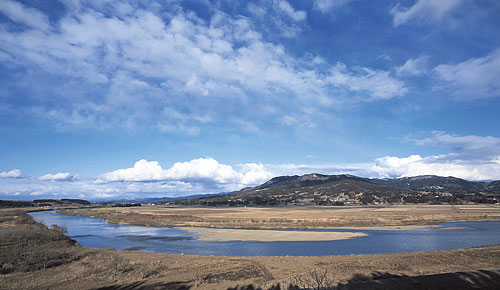Japan Travelogue Hiraizumi
The Kitakami River runs north-south through Iwate Prefecture in northern Honshu. On the west bank of the grand river there is a town called Hiraizumi. It was once the stronghold of four generations of the Oshu Fujiwara warrior clan—from the end of the 11th century to the end of the 12th, they controlled Oshu (now known as the Tohoku region).
The clan left the capital city of Kyoto for Hiraizumi, bringing Kyoto’s culture to this northern outpost. They constructed magnificent temples and formal gardens, and transformed Hiraizumi into a major urban center of Buddhism. In those days the area was rich in gold, and large quantities were used to decorate temples and Buddhist statues, adding the dazzling brilliance that only gold can give.
After arriving at JR’s Hiraizumi Station, why not first explore the history and culture? Chuson-ji Temple stands as a symbol of the old days of gold. Walk up the hill along the path called Tsukimi-zaka, past huge cedars. On the way are a number of buildings of religious significance.
Chuson-ji’s main feature is Konjiki-do Hall. To protect it from the elements, it is covered by another structure in the Buddhist style. Step inside and the golden hall stands before you, the exterior covered in gold leaf. It is awesome, but just as impressive is the interior, with altars and pillars decorated in gold, lacquer and mother-of-pearl.
The inner sanctuary has 33 statues, the central and most important one being a seated Amida Nyorai Buddha. Under them are buried the four Fujiwara governors. Konjiki-do Hall represents the Land of Perfect Bliss, a Buddhist idea of paradise where pain and suffering do not exist. The hall was inspired by Kiyohira, the first Fujiwara governor, who had the main parts of Chuson-ji Temple constructed.
Next, retrace your steps back toward the station, stopping at the Takadachi Gikei-do monument on the way. This is where another military commander of the same era met his end. His name was Minamoto no Yoshitsune, and he is a hero for the Japanese, perhaps because of the tragedy that surrounded him. He had a falling out with his older half-brother, Yoritomo, who founded the Kamakura Shogunate. Yoshitsune had to flee, and he obtained sanctuary in Hiraizumi from the third Fujiwara governor, Hidehira. But Hidehira’s son went over to Yoritomo’s side, and killed Yoshitsune. But this did not appease Yoritomo—his army defeated the Fujiwara clan and removed them from power in 1189.
